OYSTER SHELLS FROM AROUND THE WORLD INCLUDE HIGHLY POLISHED TO THE PACIFIC THORNY OYSTER AT DISCOUNT PRICING
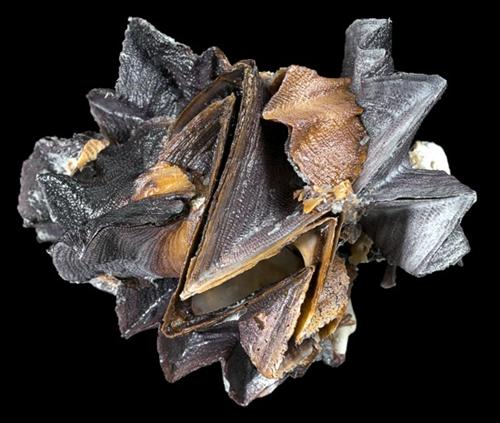
Zigzag Oyster shells of the Tropical Indo-Pacific region
H1-5
One Zigzag Oyster 4 to 5 inches......$9.10
H2-5
One Zigzag Oyster 5 or more inches......$13.50
H3-5
One Zigzag Oyster 9 inches......$21
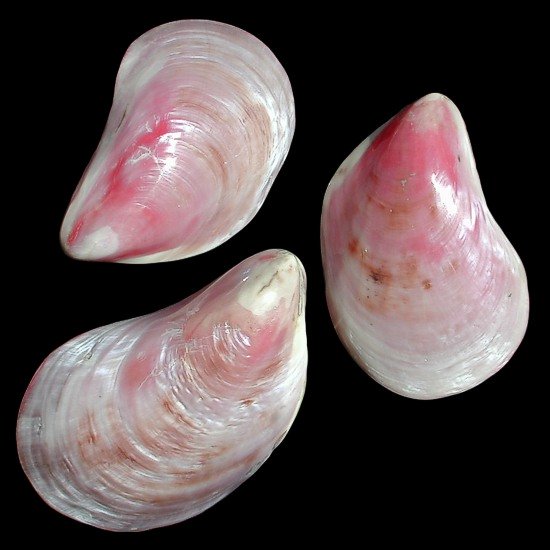
THE SELOY OYSTER SHELL
Seloy's are from the western Pacific
These are smooth bodied bivalve They popular with collectors. The picture of the Seloy shows too much pink. Ninety nine percent of the Seloy's are various shades of purple and rarely pink. Even so, the shells are very colorful. AA0-11 One Seloy Oyster 4 or more inches.....$4.10
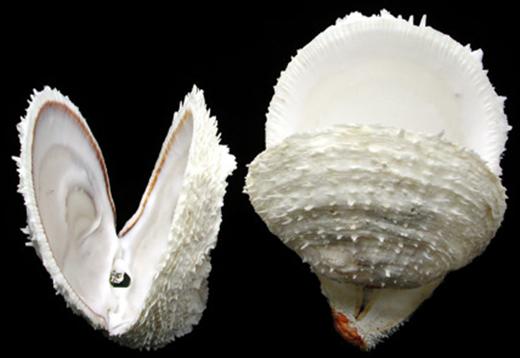
SPONDYLUS VARIUS OYSTER
Spondylus Varius, is a species of the large marine bivalve molluscan in the family. Spondylidae, the Spiny Oysters.
It lives in depths up to 99 feet, and like most bivalves, they are filter-feeders, using plankton as a food source.
This species can be found in the Indo-Pacific Oceans and off Australia, China, the Philippines, Japan, and Taiwan.
Scientific classification
Domain: Eukaryota
Kingdom: Animalia
Phylum: Mollusca
Class: Bivalve
Order: Pectinida
Family: Spondylidae
Genus: Spondylus
Species: S. varius
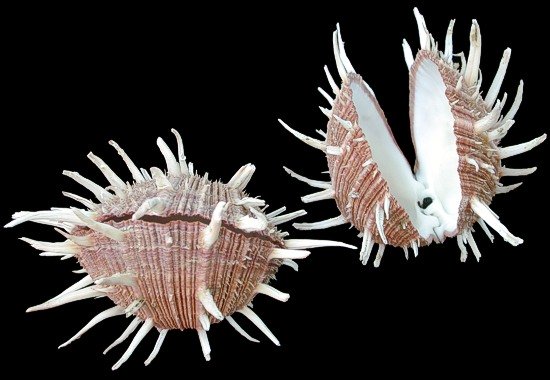
SPONDYLUS REGIUS OYSTER
Spondylus regius, the regal thorny oyster, is a species of bivalve molluscA in the family Spondylidae. It can be found in the Western Pacific, and can grow up to 7 inches in length.
Spondylus regius is found in the Red Sea, Philippines, Japan, and Coral Sea waters on coral debris from depths of 17 to 263 feet.
Scientific classification
Domain: Eukaryota
Kingdom: Animalia
Phylum: Mollusca
Class: Bivalvia
Order: Pectinida
Family: Spondylidae
Genus: Spondylus
Species: S. regius
G1-3
One Spondylus Regius Oyster pair 3 to 4 inches......$18.95
G2-3
One Spondylus Regius Oyster Pair 4 to 5 inches....$25.95
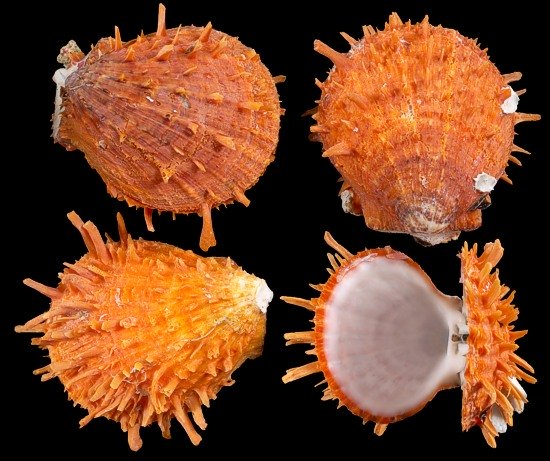
SPONDYLUS DUCALLIS OYSTER
The Spondylus Ducallis Oyster is another of the 40 some spiny oysters. This Oyster is found in the Indo-Pacific region. All are tropical water dwellers and they like the other spiny oysters attach themselves to hard objects.
Q1-5
One Spondylus Ducallis Oyster pair 3 to 4 inches ......OUT OF STOCK
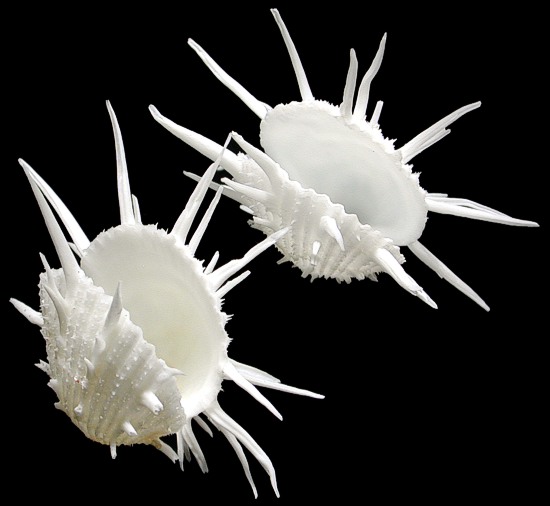
SPONDYLUS IMPERIALIS OYSTER
The Spondylus Imperialis Oyster is another spiny oyster found in the Indo-Pacific region. As with other oysters, it attaches itself to a hard surface.
This oyster can grow up to 6 inches, the most common length is about 3 inches.
The Spondylus Imperialis have been found across the Indo-West Pacific: from India and Sri Lanka to the Philippines; north to Japan and south to Indonesia.PS2-17
One Spondylus Imperialis Oyster pair 3 to 4 inches......$8.59
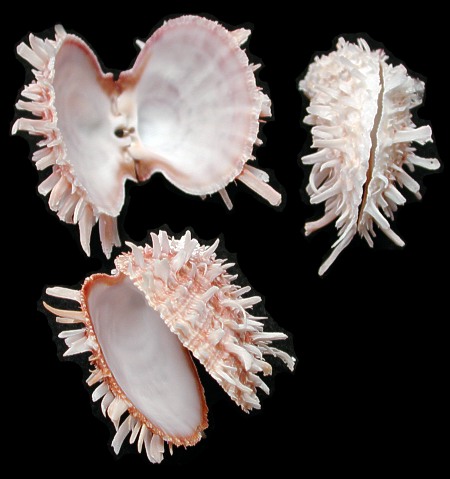
SPINY OYSTER PAIRS ASSORTED SPECIES
They are found across the Indo-Pacific region.
Spiny Oysters have been found in tropical seas as shallow as 1 foot to as deep as 150 feet.
01-5
One 3 to 4 inch Spiny Oyster Pair sold in assorted types...... $1.19
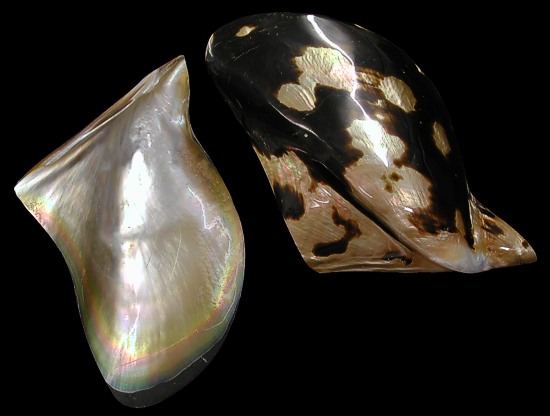
PTERIA PENGUIN Common Name BROWNLIP OYSTER
the penguin's wing oyster, is a species of marine bivalve mollusk in the family Pteriidae, the pearl oysters. It is native to the western and central Indo-Pacific region and is used for the production of cultured pearls. The generic name comes from Greek πτερον (pteron) meaning wing.
It is found attached by its byssal threads to a number of different substrates, rocks and corals (especially to Gorgonacea), at intertidal depths less 1156 feet.
Pteria penguin can reach a common shell length of about 8 inches, with a maximum length of 12 inches). The shells of this rather large species are solid and ovate. The posterior ear develops a narrow, elongated, wing-like expansion. The left valve is more inflated than the right one. The outside color of the shell ranges from dark brown to black, while the interior is nacreous silvery, a wide non-nacreous glossy black margin
Scientific classification
Domain: Eukaryota
Kingdom: AnimaliaPhylum: Mollusca
Class: Bivalvia
Order: Pteriida
Family: Pteriidae
Genus: Pteria
Species: P. penguin
P1-15
One Polished Brown Lip Oyster 4 to 5 inches ....... $2.10
P2-15
One Brownlip Oyster Shell 5 7/8 to 8 inches........ $4.25
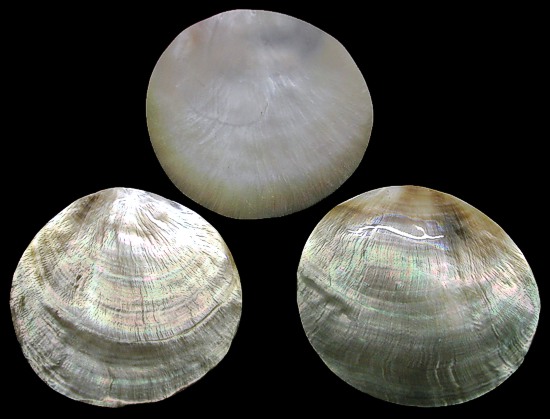
Pinctada margaritifera common name BLACKLIP OYSTER
This is a species of pearl oyster, a saltwater mollusk, a marine bivalve mollusk in the family Pteriidae. They are common in the Indo-Pacific within tropical coral reefs.
The ability of P. margaritifera to produce pearls means that the species is a valuable resource to humans. The oysters are harvested wild from coral reefs and are also commonly grown in aquaculture, in the Indo-Pacific region.
The common name of this species refers to the black coloring along the margins of the interior of the shell. Externally the shell is dark grayish brown or green, though white spots are common across the shell. Adults usually reach between 8 to 10 inches in height. A distinctive feature of the species is that the hinge has no teeth.
Pinctada margaritifera occupies a wide range throughout the Persian Gulf, Red Sea, Sudan, Papua New Guinea, Australia, French Polynesia, Cook Islands, Indonesia, Andaman and Nicobar Islands, Southwestern part of the Indian Ocean, Japan and the Pacific Ocean, and various locations on the coast of India.
The pearl oyster attaches itself to barnacles and other hard substrates via a byssus. They thrive at intertidal and subtidal zones, at depths from the low tide to up to 27 feet. Habitats are usually characterized as oligotrophic and having low turbidity. Other species, including sponges, hydroids, polychaetes, lamellibranchs, amphipods, decapods, echinoderms, and fishes, usually have close relationships with pearl oyster beds.
This species is commonly farmed and harvested for pearls, and there is general consensus that the quality of pearls from Pinctada margaritifera is the highest quality out of all the pearl oysters. Pearls form when a parasite or other irritant enters into the oyster and nacre is released by the oyster to coat the object, eventually creating a small pearl. It is a popular myth that sand is a common irritant that induces pearl nucleation, however, this is very rarely, if ever, the case. Bivalves are able to flush sand from their bodies extremely effectively, and studies of pearl nuclei have shown that the overwhelming majority form from parasitic incursion, other organic irritants, or even tissue damage. The oyster's release of the nacre serves as an adaptation of the immune system to isolate the invasive particle and irritation. P. margaritifera in particular produces gray or black pearls.
Scientific classification
Domain: Eukaryota
Kingdom: Animalia
Phylum: Mollusca
Class: Bivalvia
Order: Pteriida
Family: Pteriidae
Genus: Pinctada
Species: P. margaritifera
I1-15 One Single shell of the Bivalve Blacklip Oyster shell polished 1 to 1 3/8 inches...... .75I2-15
One single shell of the bivalve Blacklip Polished Oyster shell 1 1/2 to 2 inches...... .75
I3-15
One single shell of the bivalve Blacklip Polished Oyster shell 2 to 2 3/8 inches...... $1.15
I4-15
One single shell of the bivalve Blacklip Polished Oyster shell 2 1/2 to 2 7/8 inches...... $1.75
I5-15 One single shell of the bivalve Blacklip Polished Oyster shell 2 7/8 to 4 inches...... $2.95
I6-15
One single shell of the bivalve Blacklip Polished Oyster shell 4 to 4 3/8 inches.....$7.75
I7-15
One single shell of the bivalve Blacklip Polished Oyster shell 4 1/2 to 5 inches......OUT OF STOCK
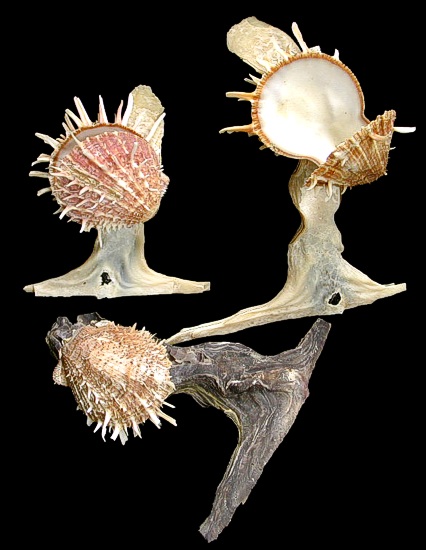
Hammer Head Oyster with Spiny Oyster
Malleidae, or hammer oyster, is a family of saltwater clams. They are related to the pearl oysters, in the order Pteriida[1] and the superfamily Pterioidea.
The shells of most of these animals are T-shaped, with the hinge along the top of the T, and with the byssus emerging from the hinge. An oblique ligament holds the hinge. The shell is partially nacreous. There is a single, large adductor muscle. The exhalant current exits at the hinge.
Most hammer oysters live in tropical, coralline areas.
Scientific classification
Domain: Eukaryota
Kingdom: Animalia
Phylum: Mollusca
Class: Bivalvia
Order: Pteriida
Super family: Pterioidea
Family: Malleidae
E1-5
One Hammer Head Oyster shell with Spiny oyster 5 7/8 to 7 inches ..... $2.10
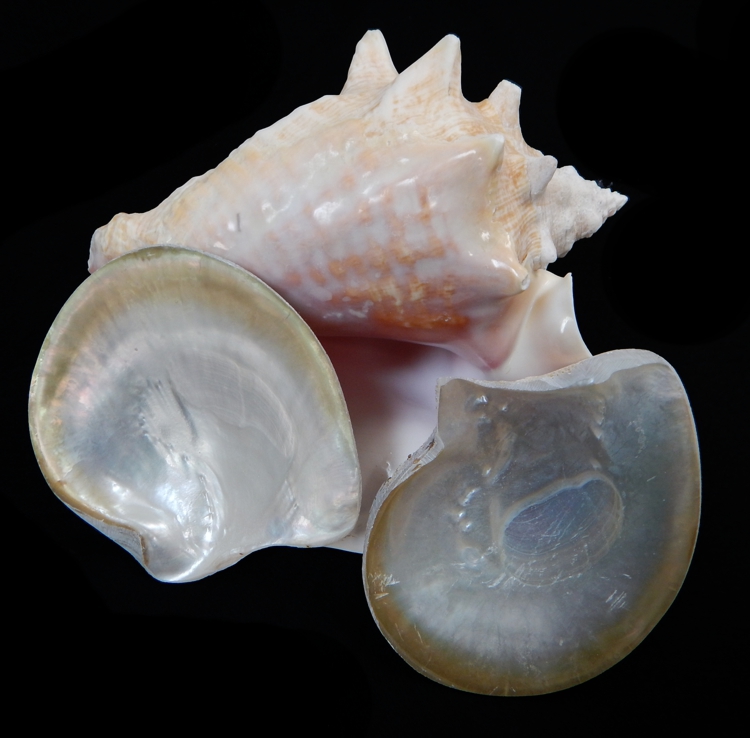
NATURAL PEARL OYSTER SHELL This is a Natural Pearl Oyster shell that has a Ruff back and a natural pearl finish inside.
XX1-15
One natural Pearl Oyster Shell 5 to 6 inches $2.10